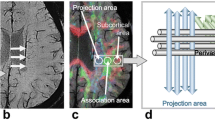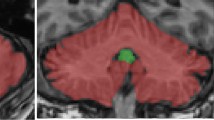Abstract
Purpose
We investigated whether diffusion kurtosis imaging (DKI) and quantitative susceptibility mapping (QSM) could detect pathological changes that occur in Parkinson’s disease (PD), multiple system atrophy with predominant parkinsonism (MSA-P) or predominant cerebellar ataxia (MSA-C), and progressive supranuclear palsy syndrome (PSPS) and thus be used for differential diagnosis that is often difficult.
Methods
Seventy patients (41 with PD, 6 with MSA-P, 7 with MSA-C, 16 with PSPS) and 20 healthy controls were examined using a 3.0 T MRI scanner. From DKI and QSM data, we automatically obtained mean kurtosis (MK), fractional anisotropy (FA), and mean diffusivity (MD) values of the midbrain tegmentum (MBT), pontine crossing tract (PCT), and superior/middle cerebellar peduncles (CPs), which were used to calculate diffusion MBT/PCT ratios (dMPRs) and diffusion superior/middle CP ratios (dCPRs), as well as MS (magnetic susceptibility) values of the anterior/posterior putamen (PUa and PUp) and globus pallidus (GP).
Results
dMPRs of MK were significantly decreased in PSPS and increased in MSA-C compared with the other groups, while dCPRs of MK showed significant differences only between MSA-C and PD, PSPS, or control. MS values were significantly increased in the PUp of MSA-P and in the PUa and GP of PSPS compared with those in PD. The combined use of MK-dMPR and MS-PUp showed sensitivities of 83–100% and specificities of 81–100% for discriminating among the disease groups, respectively.
Conclusion
A quantitative assessment using DKI and QSM analyses, particularly MK-dMPR and MS-PUp values, can readily identify patients with parkinsonism.


Similar content being viewed by others
References
Gilman S, Wenning GK, Low PA, Brooks DJ, Mathias CJ, Trojanowski JQ, Wood NW, Colosimo C, Durr A, Fowler CJ, Kaufmann H, Klockgether T, Lees A, Poewe W, Quinn N, Revesz T, Robertson D, Sandroni P, Seppi K, Vidailhet M (2008) Second consensus statement on the diagnosis of multiple system atrophy. Neurology 71(9):670–676. doi:10.1212/01.wnl.0000324625.00404.15
Litvan I, Agid Y, Calne D, Campbell G, Dubois B, Duvoisin RC, Goetz CG, Golbe LI, Grafman J, Growdon JH, Hallett M, Jankovic J, Quinn NP, Tolosa E, Zee DS (1996) Clinical research criteria for the diagnosis of progressive supranuclear palsy (Steele-Richardson-Olszewski syndrome): report of the NINDS-SPSP international workshop. Neurology 47(1):1–9
Hughes AJ, Daniel SE, Kilford L, Lees AJ (1992) Accuracy of clinical diagnosis of idiopathic Parkinson’s disease: a clinico-pathological study of 100 cases. J Neurol Neurosurg Psychiatry 55(3):181–184
Hughes AJ, Daniel SE, Ben-Shlomo Y, Lees AJ (2002) The accuracy of diagnosis of parkinsonian syndromes in a specialist movement disorder service. Brain 125(Pt 4):861–870
Massey LA, Micallef C, Paviour DC, O'Sullivan SS, Ling H, Williams DR, Kallis C, Holton JL, Revesz T, Burn DJ, Yousry T, Lees AJ, Fox NC, Jager HR (2012) Conventional magnetic resonance imaging in confirmed progressive supranuclear palsy and multiple system atrophy. Mov Disord 27(14):1754–1762. doi:10.1002/mds.24968
Massey LA, Jager HR, Paviour DC, O'Sullivan SS, Ling H, Williams DR, Kallis C, Holton J, Revesz T, Burn DJ, Yousry T, Lees AJ, Fox NC, Micallef C (2013) The midbrain to pons ratio: a simple and specific MRI sign of progressive supranuclear palsy. Neurology 80(20):1856–1861. doi:10.1212/WNL.0b013e318292a2d2
Quattrone A, Nicoletti G, Messina D, Fera F, Condino F, Pugliese P, Lanza P, Barone P, Morgante L, Zappia M, Aguglia U, Gallo O (2008) MR imaging index for differentiation of progressive supranuclear palsy from Parkinson disease and the Parkinson variant of multiple system atrophy. Radiology 246(1):214–221. doi:10.1148/radiol.2453061703
Scherfler C, Gobel G, Muller C, Nocker M, Wenning GK, Schocke M, Poewe W, Seppi K (2016) Diagnostic potential of automated subcortical volume segmentation in atypical parkinsonism. Neurology 86(13):1242–1249. doi:10.1212/WNL.0000000000002518
Meijer FJ, Bloem BR, Mahlknecht P, Seppi K, Goraj B (2013) Update on diffusion MRI in Parkinson’s disease and atypical parkinsonism. J Neurol Sci 332(1–2):21–29. doi:10.1016/j.jns.2013.06.032
Cochrane CJ, Ebmeier KP (2013) Diffusion tensor imaging in parkinsonian syndromes: a systematic review and meta-analysis. Neurology 80(9):857–864. doi:10.1212/WNL.0b013e318284070c
Meijer FJ, van Rumund A, Tuladhar AM, Aerts MB, Titulaer I, Esselink RA, Bloem BR, Verbeek MM, Goraj B (2015) Conventional 3T brain MRI and diffusion tensor imaging in the diagnostic workup of early stage parkinsonism. Neuroradiology 57(7):655–669. doi:10.1007/s00234-015-1515-7
Tuch DS, Reese TG, Wiegell MR, Makris N, Belliveau JW, Wedeen VJ (2002) High angular resolution diffusion imaging reveals intravoxel white matter fiber heterogeneity. Magn Reson Med 48(4):577–582. doi:10.1002/mrm.10268
Planetta PJ, Ofori E, Pasternak O, Burciu RG, Shukla P, DeSimone JC, Okun MS, McFarland NR, Vaillancourt DE (2016) Free-water imaging in Parkinson’s disease and atypical parkinsonism. Brain 139(Pt 2):495–508. doi:10.1093/brain/awv361
Jensen JH, Helpern JA (2010) MRI quantification of non-Gaussian water diffusion by kurtosis analysis. NMR Biomed 23(7):698–710. doi:10.1002/nbm.1518
Wang JJ, Lin WY, Lu CS, Weng YH, Ng SH, Wang CH, Liu HL, Hsieh RH, Wan YL, Wai YY (2011) Parkinson disease: diagnostic utility of diffusion kurtosis imaging. Radiology 261(1):210–217. doi:10.1148/radiol.11102277
Ito K, Sasaki M, Ohtsuka C, Yokosawa S, Harada T, Uwano I, Yamashita F, Higuchi S, Terayama Y (2015) Differentiation among parkinsonisms using quantitative diffusion kurtosis imaging. Neuroreport 26(5):267–272. doi:10.1097/WNR.0000000000000341
Haacke EM, Xu Y, Cheng YC, Reichenbach JR (2004) Susceptibility weighted imaging (SWI). Magn Reson Med 52(3):612–618. doi:10.1002/mrm.20198
Han YH, Lee JH, Kang BM, Mun CW, Baik SK, Shin YI, Park KH (2013) Topographical differences of brain iron deposition between progressive supranuclear palsy and parkinsonian variant multiple system atrophy. J Neurol Sci 325(1–2):29–35. doi:10.1016/j.jns.2012.11.009
Meijer FJ, van Rumund A, Fasen BA, Titulaer I, Aerts M, Esselink R, Bloem BR, Verbeek MM, Goraj B (2015) Susceptibility-weighted imaging improves the diagnostic accuracy of 3T brain MRI in the work-up of parkinsonism. AJNR Am J Neuroradiol 36(3):454–460. doi:10.3174/ajnr.A4140
Haacke EM, Liu S, Buch S, Zheng W, Wu D, Ye Y (2015) Quantitative susceptibility mapping: current status and future directions. Magn Reson Imaging 33(1):1–25. doi:10.1016/j.mri.2014.09.004
Eskreis-Winkler S, Zhang Y, Zhang J, Liu Z, Dimov A, Gupta A, Wang Y (2017) The clinical utility of QSM: disease diagnosis, medical management, and surgical planning. NMR Biomed 30(4). doi:10.1002/nbm.3668
Wang Y, Spincemaille P, Liu Z, Dimov A, Deh K, Li J, Zhang Y, Yao Y, Gillen KM, Wilman AH, Gupta A, Tsiouris AJ, Kovanlikaya I, Chiang GC, Weinsaft JW, Tanenbaum L, Chen W, Zhu W, Chang S, Lou M, Kopell BH, Kaplitt MG, Devos D, Hirai T, Huang X, Korogi Y, Shtilbans A, Jahng GH, Pelletier D, Gauthier SA, Pitt D, Bush AI, Brittenham GM, Prince MR (2017) Clinical quantitative susceptibility mapping (QSM): biometal imaging and its emerging roles in patient care. J Magn Reson Imaging. doi:10.1002/jmri.25693
Yokosawa S, Sasaki M, Bito Y, Ito K, Yamashita F, Goodwin J, Higuchi S, Kudo K (2016) Optimization of scan parameters to reduce acquisition time for diffusion kurtosis imaging at 1.5T. Magn Reson Med Sci 15(1):41–48. doi:10.2463/mrms.2014-0139
Ito K, Kudo M, Sasaki M, Saito A, Yamashita F, Harada T, Yokosawa S, Uwano I, Kameda H, Terayama Y (2016) Detection of changes in the periaqueductal gray matter of patients with episodic migraine using quantitative diffusion kurtosis imaging: preliminary findings. Neuroradiology 58(2):115–120. doi:10.1007/s00234-015-1603-8
Sato R, Shirai T, Taniguchi Y, Murase T, Bito Y, Ochi H (2017) Quantitative susceptibility mapping using the multiple dipole-inversion combination with k-space segmentation method. Magn Reson Med Sci (in press)
Sun H, Wilman AH (2014) Background field removal using spherical mean value filtering and Tikhonov regularization. Magn Reson Med 71(3):1151–1157. doi:10.1002/mrm.24765
Lim IA, Faria AV, Li X, Hsu JT, Airan RD, Mori S, van Zijl PC (2013) Human brain atlas for automated region of interest selection in quantitative susceptibility mapping: application to determine iron content in deep gray matter structures. NeuroImage 82:449–469. doi:10.1016/j.neuroimage.2013.05.127
Oishi K, Faria A, Jiang H, Li X, Akhter K, Zhang J, Hsu JT, Miller MI, van Zijl PC, Albert M, Lyketsos CG, Woods R, Toga AW, Pike GB, Rosa-Neto P, Evans A, Mazziotta J, Mori S (2009) Atlas-based whole brain white matter analysis using large deformation diffeomorphic metric mapping: application to normal elderly and Alzheimer’s disease participants. NeuroImage 46(2):486–499
Guglielmetti C, Veraart J, Roelant E, Mai Z, Daans J, Van Audekerke J, Naeyaert M, Vanhoutte G, Delgado YPR, Praet J, Fieremans E, Ponsaerts P, Sijbers J, Van der Linden A, Verhoye M (2016) Diffusion kurtosis imaging probes cortical alterations and white matter pathology following cuprizone induced demyelination and spontaneous remyelination. NeuroImage 125:363–377. doi:10.1016/j.neuroimage.2015.10.052
Steven AJ, Zhuo J, Melhem ER (2014) Diffusion kurtosis imaging: an emerging technique for evaluating the microstructural environment of the brain. AJR Am J Roentgenol 202(1):W26–W33. doi:10.2214/AJR.13.11365
Zhuo J, Xu S, Proctor JL, Mullins RJ, Simon JZ, Fiskum G, Gullapalli RP (2012) Diffusion kurtosis as an in vivo imaging marker for reactive astrogliosis in traumatic brain injury. NeuroImage 59(1):467–477. doi:10.1016/j.neuroimage.2011.07.050
Assaf Y, Pasternak O (2008) Diffusion tensor imaging (DTI)-based white matter mapping in brain research: a review. J Mol Neurosci 34(1):51–61. doi:10.1007/s12031-007-0029-0
Tsukamoto K, Matsusue E, Kanasaki Y, Kakite S, Fujii S, Kaminou T, Ogawa T (2012) Significance of apparent diffusion coefficient measurement for the differential diagnosis of multiple system atrophy, progressive supranuclear palsy, and Parkinson’s disease: evaluation by 3.0-T MR imaging. Neuroradiology 54(9):947–955. doi:10.1007/s00234-012-1009-9
Wang J, Wai Y, Lin WY, Ng S, Wang CH, Hsieh R, Hsieh C, Chen RS, Lu CS (2010) Microstructural changes in patients with progressive supranuclear palsy: a diffusion tensor imaging study. J Magn Reson Imaging 32(1):69–75. doi:10.1002/jmri.22229
Wenning GK, Tison F, Elliott L, Quinn NP, Daniel SE (1996) Olivopontocerebellar pathology in multiple system atrophy. Mov Disord 11(2):157–162. doi:10.1002/mds.870110207
Dickson DW (2012) Parkinson’s disease and parkinsonism: neuropathology. Cold Spring Harb Perspect Med 2(8). doi:10.1101/cshperspect.a009258
Berg D, Hochstrasser H (2006) Iron metabolism in Parkinsonian syndromes. Mov Disord 21(9):1299–1310. doi:10.1002/mds.21020
Matsusue E, Fujii S, Kanasaki Y, Sugihara S, Miyata H, Ohama E, Ogawa T (2008) Putaminal lesion in multiple system atrophy: postmortem MR-pathological correlations. Neuroradiology 50(7):559–567. doi:10.1007/s00234-008-0381-y
Perez M, Valpuesta JM, de Garcini EM, Quintana C, Arrasate M, Lopez Carrascosa JL, Rabano A, Garcia de Yebenes J, Avila J (1998) Ferritin is associated with the aberrant tau filaments present in progressive supranuclear palsy. Am J Pathol 152(6):1531–1539
Li J, Chang S, Liu T, Wang Q, Cui D, Chen X, Jin M, Wang B, Pei M, Wisnieff C, Spincemaille P, Zhang M, Wang Y (2012) Reducing the object orientation dependence of susceptibility effects in gradient echo MRI through quantitative susceptibility mapping. Magn Reson Med 68(5):1563–1569. doi:10.1002/mrm.24135
Tripathi M, Tang CC, Feigin A, De Lucia I, Nazem A, Dhawan V, Eidelberg D (2016) Automated differential diagnosis of early parkinsonism using metabolic brain networks: a validation study. J Nucl Med 57(1):60–66. doi:10.2967/jnumed.115.161992
Holtbernd F, Eidelberg D (2014) The utility of neuroimaging in the differential diagnosis of parkinsonian syndromes. Semin Neurol 34(2):202–209. doi:10.1055/s-0034-1381733
Gong NJ, Wong CS, Hui ES, Chan CC, Leung LM (2015) Hemisphere, gender and age-related effects on iron deposition in deep gray matter revealed by quantitative susceptibility mapping. NMR Biomed 28(10):1267–1274. doi:10.1002/nn3366
Author information
Authors and Affiliations
Corresponding author
Ethics declarations
Funding
This study was partly funded by a Grant-in-Aid (Nanchi-030) from the Ministry of Health, Labor and Welfare of Japan, a Grant-in-Aid for Strategic Medical Science Research (S1491001) from the Ministry of Education, Culture, Sports, Science, and Technology of Japan, and JSPS KAKENHI (16K19520, 25861119, 25461325).
Conflict of interest
SY and RS are employees of Hitachi, Ltd. MS has received an honorarium and research grants from Hitachi Medical Corp.
Ethical approval
All procedures performed in studies involving human participants were in accordance with the ethical standards of the institutional and/or national research committee and with the 1964 Helsinki declaration and its later amendments or comparable ethical standards.
Informed consent
Informed consent was obtained from all individual participants included in the study.
Rights and permissions
About this article
Cite this article
Ito, K., Ohtsuka, C., Yoshioka, K. et al. Differential diagnosis of parkinsonism by a combined use of diffusion kurtosis imaging and quantitative susceptibility mapping. Neuroradiology 59, 759–769 (2017). https://doi.org/10.1007/s00234-017-1870-7
Received:
Accepted:
Published:
Issue Date:
DOI: https://doi.org/10.1007/s00234-017-1870-7




